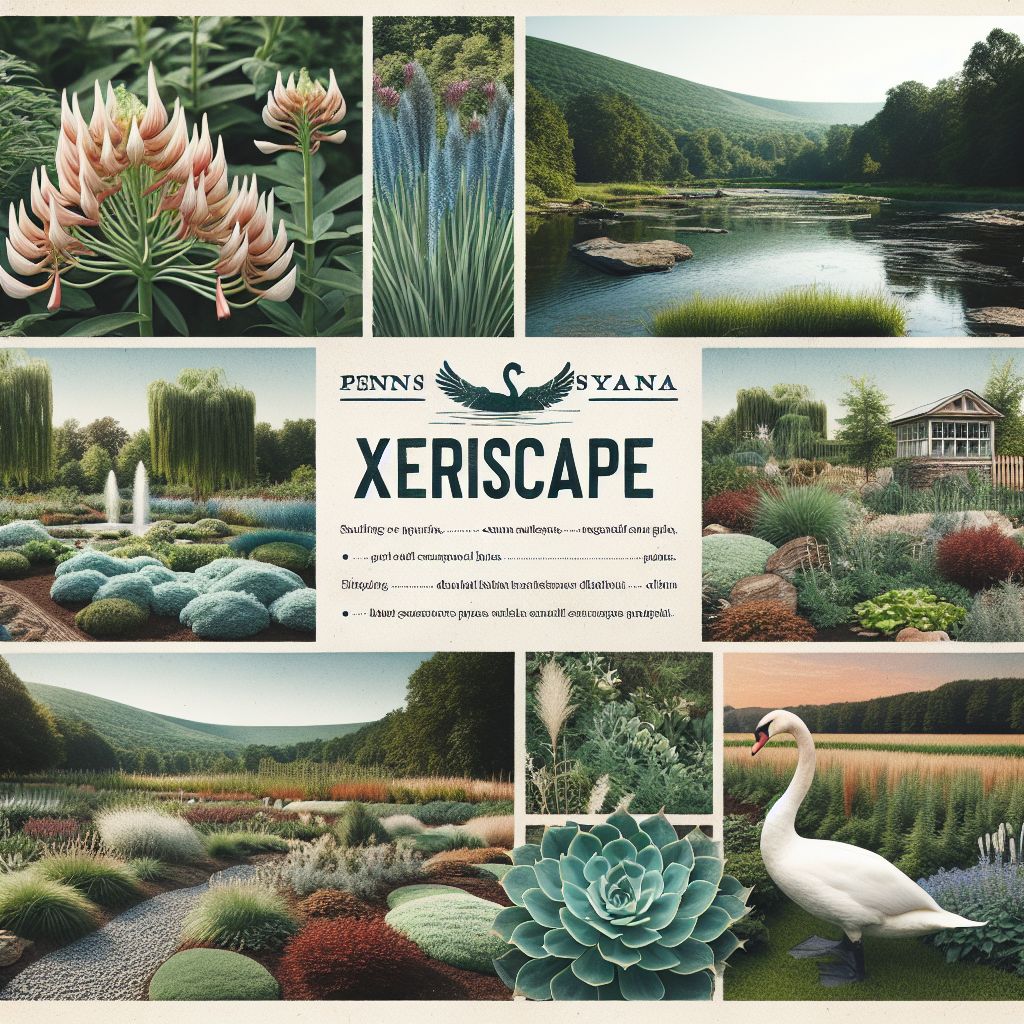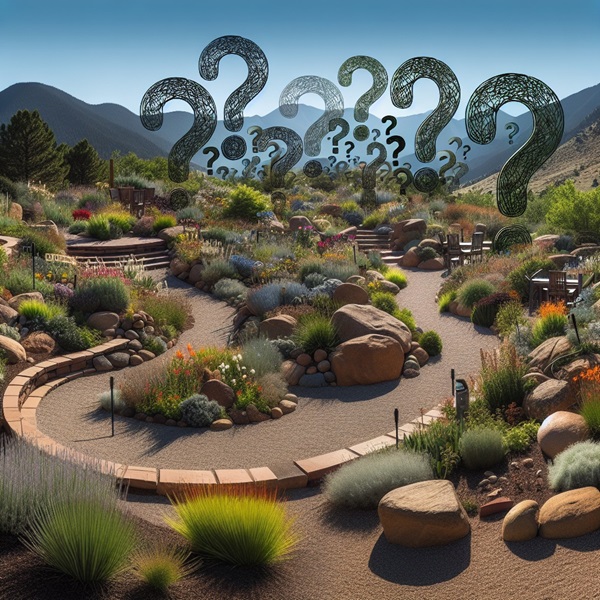
Key Takeaways: Smart Landscaping for a Greener Pennsylvania
- Pennsylvania law supports the use of drought-tolerant, native plants in HOA-regulated communities.
- Xeriscaping is a sustainable landscaping practice that reduces the need for irrigation.
- Selecting the right plants and materials is crucial for a successful xeriscape garden in Pennsylvania.
- Understanding and working with HOA regulations is key to implementing
in your community. - Community involvement and education are essential for fostering acceptance of xeriscaping.
Xeriscape Basics: Embracing a Sustainable Future
Imagine stepping outside to a garden that’s not only stunning to look at but also kind to our planet. That’s the heart of xeriscaping—a landscaping philosophy that conserves water and supports local ecosystems. And in Pennsylvania, where weather can be as unpredictable as a squirrel darting across your lawn, xeriscaping isn’t just smart; it’s essential.
Xeriscaping revolves around the idea of creating landscapes that require minimal water beyond what nature provides. It’s not about sacrificing beauty for sustainability; it’s about combining the two in harmony. Besides that, xeriscaping can save you time and money on maintenance, making it a win-win for busy homeowners and Mother Nature.
Defining Xeriscaping and Its Environmental Impact
Xeriscaping comes from the Greek word ‘xeros,’ meaning dry, and ‘scape,’ as in landscape. It’s not about turning your yard into a barren desert; rather, it’s about making smart choices that reduce the need for supplemental watering. This is crucial because, as we all know, water is a precious resource.
When you xeriscape, you’re not just saving water. You’re also creating a habitat for local wildlife, reducing chemical runoff, and cutting down on your carbon footprint by requiring less mowing and maintenance. In short, xeriscaping is about making a positive impact, one plant at a time.
Core Principles of a Successful Xeriscaping Project
Whether you’re a seasoned gardener or a green-thumbed newbie, the core principles of xeriscaping are simple to grasp:
- Planning and Design: Start with a solid plan that considers your property’s specific conditions.
- Soil Improvement: Enhance your soil to retain moisture and provide nutrients.
- Efficient Irrigation: Use water wisely with systems like drip irrigation that target plant roots.
- Appropriate Plant Selection: Choose plants that thrive in Pennsylvania’s climate without extra watering.
- Mulching: Cover soil with mulch to reduce evaporation and keep roots cool.
- Maintenance: Regular but minimal care will keep your xeriscape healthy and attractive.
Now, let’s dive into the specifics of xeriscaping in Pennsylvania, where local conditions and HOA regulations play a significant role in your garden’s success.
Pennsylvania Plant Life: Making Wise Choices
Choosing the right plants is like casting actors for a play; you need stars that can perform well under the local spotlight. In Pennsylvania, this means selecting plants that are up to the challenge of our varied climate—from the humid summers to the frosty winters.
Navigating the Native Flora: Best Picks for Your Garden
Native plants are the unsung heroes of a Pennsylvania xeriscape. They’re accustomed to our weather patterns and soil types, which means they’re naturally low-maintenance. Here’s a quick list of native plants that are perfect for your water-wise garden:
- Black-Eyed Susan: A cheerful yellow flower that’s as tough as it is beautiful.
- Switchgrass: An ornamental grass that stands tall and provides year-round interest.
- Butterfly Weed: A magnet for monarch butterflies with its vivid orange blooms.
- Serviceberry: A small tree or shrub that offers four-season appeal with flowers, fruits, and fall color.
- Eastern Redbud: A springtime showstopper with pinkish-purple flowers that light up the landscape.
When you choose native plants, you’re not just making your life easier; you’re supporting local wildlife and preserving Pennsylvania’s natural heritage.
Adapting Non-Natives: Which Ones Work in PA
Not all non-native plants are water-guzzlers. Some have adapted well to our local conditions and can be included in your xeriscape.
Remember, the key is to select plants that won’t demand extra water or care once they’re established. It’s about working with nature, not against it.
The Legal Landscape: Navigating HOA Regulations
Homeowners’ associations can have a lot to say about what you do in your yard. But don’t let that discourage you from xeriscaping. In Pennsylvania, state law is on your side, protecting your right to create a water-conserving landscape. Most importantly, you need to understand these regulations so you can work with your HOA, not against it.
Understanding Your Rights
You have the right to use native, drought-tolerant plants and to design a landscape that conserves water. HOAs must balance aesthetic concerns with environmental responsibility. They can’t flat-out deny your xeriscape plans if they align with water conservation goals. This is your ace in the hole when you’re planning a xeriscape garden.
But, it’s not just about rights; it’s about cooperation. Engaging with your HOA early on can pave the way for a smoother transition to xeriscaping. Share your vision, back it up with solid information, and be open to feedback. Together, you can create a landscape that’s both beautiful and sustainable.
Common HOA Concerns and How to Address Them
HOAs might worry about xeriscaped yards looking unkempt or not fitting in with the neighborhood’s aesthetic. Here’s how to address those concerns:
- Show them examples of well-designed xeriscapes that enhance curb appeal.
- Explain the environmental and economic benefits of reduced water use and maintenance.
- Propose a trial period for your xeriscape, offering to make adjustments if needed.
With a bit of diplomacy and a lot of planning, you can transform your yard into a xeriscape paradise that even the most stringent HOA would be proud of.
Common HOA Concerns and How to Address Them
Homeowners’ associations often worry that xeriscaping might lead to a decrease in property values due to unconventional aesthetics. To address these concerns, it’s important to communicate the benefits clearly. For example, you can explain that xeriscaping, when done correctly, can lead to significant water savings and reduced maintenance costs. Besides that, a well-designed xeriscape can be just as beautiful as a traditional landscape, if not more so.
Building Your Xeriscape: A Step-by-Step Process
Building a xeriscape in Pennsylvania is a journey that starts with a single step: planning. This initial phase is about understanding your space, your climate, and your soil. It’s about envisioning the garden that not only meets your aesthetic preferences but also fulfills the practical needs of sustainability. This step is about mapping out your dreams on paper and preparing to bring them to life.
Designing Your Layout: The Importance of Planning
Designing your xeriscape layout is a creative process that requires you to consider both form and function. You’ll want to think about how the space will be used, how it will look throughout the seasons, and how it will fit into the larger landscape of your neighborhood. Start by sketching out your property and marking areas for different types of plants, pathways, and possibly a rain garden or two. Remember, the goal is to create a cohesive and sustainable design that’s tailored to Pennsylvania’s unique environment.
Planting and Maintenance: Long-Term Success Tactics
After planning comes planting, the stage where your xeriscape starts to take root. Choose your plants based on their ability to thrive in Pennsylvania’s climate and their water requirements. Group plants with similar needs together to make watering more efficient. As for maintenance, it’s all about the long game. Mulch regularly, prune as needed, and keep an eye out for pests. With these tactics, your xeriscape will not only survive but flourish.

Water-Smart Gardening: Techniques to Optimize Irrigation
Even though xeriscaping is about reducing the need for water, smart irrigation practices are still important. Pennsylvania’s weather can be fickle, and there may be dry spells when your plants need a little extra help. The key is to use water as efficiently as possible, giving your plants enough to thrive without wasting this precious resource.
Maximizing Rainfall: Collection and Distribution Strategies
One of the best ways to optimize irrigation is to work with what nature provides. Collecting rainwater in barrels is a simple and effective way to water your xeriscape garden. You can then distribute this water using a watering can or a soaker hose, targeting the base of your plants to minimize evaporation and runoff.
- Install rain barrels at downspouts to catch runoff from your roof.
- Use a soaker hose or drip irrigation system for targeted watering.
- Consider the slope of your garden to prevent water from pooling in one area.
By maximizing rainfall, you’re not just saving water; you’re also saving money on your water bill. It’s a straightforward strategy that pays off in more ways than one. For more detailed insights, explore our guide on xeriscaping and water conservation techniques.
Drip Irrigation: Efficient Watering for Plant Health
Drip irrigation is a game-changer for xeriscaping. It delivers water directly to the roots of your plants, where it’s needed most. This method is far more efficient than sprinklers, which can lose a lot of water to evaporation and wind. Installing a drip irrigation system might seem like a big step, but it’s one that can make a huge difference in the health of your xeriscape garden.
And remember, healthy plants are better able to withstand the challenges of Pennsylvania’s climate, from scorching summers to freezing winters.
Community Involvement: Sparking Neighborhood Change
Creating a xeriscape is not just about your own garden; it’s about inspiring others to consider the benefits of water-wise landscaping. By getting your community involved, you can create a ripple effect that leads to more sustainable practices throughout your neighborhood and beyond.
Hosting Information Sessions: Education as a Tool for Change
Education is a powerful tool for change. Hosting an information session can demystify xeriscaping for your neighbors and your HOA. Use this opportunity to showcase the beauty and practicality of xeriscaped gardens. Share resources, provide plant lists, and perhaps even organize a tour of your own garden. When people see xeriscaping in action, they’re more likely to embrace it.
These sessions can also be a platform for discussing the broader benefits of xeriscaping, such as its positive impact on local wildlife and the environment. By educating your community, you’re planting seeds for a greener future.
Creating Xeriscaping Incentives: Encouraging Participation
Finally, consider working with local nurseries or gardening groups to create incentives for xeriscaping. This could be in the form of discounts on native plants, free workshops, or even a neighborhood competition for the best xeriscape design. Incentives can motivate those who are on the fence about xeriscaping to take the plunge.
By fostering a sense of community around sustainable gardening practices, you’re not just changing landscapes; you’re building a movement. And in Pennsylvania, where every drop of water counts, that movement can lead to a more resilient and beautiful state for all of us.
Here is the data table with the requested information:
| Plant | Description | Estimated Cost |
|---|---|---|
| Russian Sage (Perovskia atriplicifolia) | Drought-tolerant, aromatic shrub with purple flowers; native to Pennsylvania | $10-$20 per plant |
| Black-eyed Susan (Rudbeckia fulgida) | Bright yellow daisy-like flowers; native perennial that thrives in dry conditions | $5-$10 per plant |
| Blue Fescue (Festuca glauca) | Ornamental grass with blue-green foliage; low-water requirement | $8-$15 per plant |
| Butterfly Weed (Asclepias tuberosa) | Vibrant orange flowers that attract pollinators; native to Pennsylvania | $7-$12 per plant |
| Sedum (Sedum cvs.) | Succulent groundcover with various color foliage; very drought-tolerant | $6-$10 per plant |
Reference
https://extension.psu.edu/programs/master-gardener/counties/cumberland/demonstration-gardens/xeriscape-gardens
https://www.panativeplantsociety.org/
https://www.hoamanagement.com/

Frequently Asked Questions (FAQ)
Can Xeriscaping Save Money in the Long Run?
Absolutely! While the initial setup of a xeriscape garden might involve some upfront costs, in the long run, it’s a smart financial move. Because xeriscaping requires less water, fewer chemicals, and less maintenance, you’ll see savings on your water bills and gardening expenses. Over time, these savings can be significant, making xeriscaping a cost-effective choice for Pennsylvania homeowners.
How Do I Start a Conversation with My HOA About Xeriscaping?
Starting the conversation with your HOA about xeriscaping is all about preparation. Gather information on the benefits of xeriscaping, create a detailed plan for your landscape, and be ready to show how it can enhance the community’s aesthetic and sustainability goals. Approach the conversation with a collaborative spirit, and be open to finding a middle ground that satisfies both your vision and the HOA’s guidelines.
What Are the Best Drought-Resistant Plants for Pennsylvania?
In Pennsylvania, some of the best drought-resistant plants include Coneflower, Yarrow, and Sedum. These plants are not only tough and able to withstand dry conditions, but they also add a burst of color and texture to your garden. Always choose plants that are suited to your specific region in Pennsylvania for the best results.
Is Xeriscaping Suitable for All Types of Properties?
Yes, xeriscaping can be adapted to nearly any type of property in Pennsylvania, from small urban yards to large rural landscapes. The key is to tailor the xeriscape design to fit the unique conditions and constraints of your property, ensuring that it meets your needs while also conserving water.
How Can I Maintain a Xeriscape Garden Year-Round?
Maintaining a xeriscape garden year-round involves several simple practices:
- Regularly check and maintain your irrigation system to ensure it’s functioning efficiently.
- Apply mulch to reduce evaporation and suppress weeds.
- Prune and deadhead plants to encourage healthy growth and blooming.
- Monitor for pests and diseases and address them promptly using eco-friendly methods.
- Adjust your plant care seasonally, as Pennsylvania’s weather changes.
With these practices, your xeriscape garden will remain a vibrant and sustainable part of your home throughout the year.
In conclusion, xeriscaping in Pennsylvania is not just a gardening trend; it’s a lifestyle choice that reflects a commitment to environmental stewardship and community well-being. By embracing xeriscaping, you’re taking a step towards a more sustainable future, and you’re setting an example for others to follow. Whether you’re dealing with HOA regulations, selecting the right plants, or seeking ways to engage your community, remember that every effort counts. Your garden can be a testament to the beauty and resilience of nature, and with each plant that thrives without excess water, you’re contributing to a greener Pennsylvania.
Now, go ahead and transform your garden into a xeriscape oasis. With the right knowledge, a bit of planning, and a dash of creativity, you’ll create a space that saves water, supports local ecosystems, and brings joy for years to come. Happy xeriscaping!
When considering xeriscaping in Pennsylvania, it’s important to be aware of your local Homeowners Association (HOA) regulations, as they can vary significantly. Additionally, selecting the right plants is crucial for a successful xeriscape. Opt for native plants that are well-adapted to Pennsylvania’s climate and can thrive with minimal water. This not only conserves water but also supports local biodiversity.




Leave a Reply